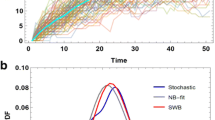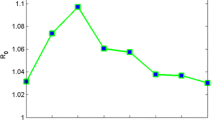Summary
A mathematical model for schistosomiasis is developed under the hypothesis of promiscuous mating between mature schistosomes. The model is used to study epidemiology, control, and eradication of schistosome infections. Comparisons are made with previously published models that deal with monogamous mating and with parthenogenesis. We find that the two modes of mating give results that are essentially similar. On the other hand, essential differences exist between either mode of mating and the parthenogenetic case. Thus, we conclude that it is not of essential importance to find out if mature schistosomes are monogamous or promiscuous. A second conclusion is that the simplifying assumption of parthenogenetic egg-laying of schistosomes is not acceptable.
Similar content being viewed by others
References
Barbour, A. D.: A stochastic model for the transmission of bilharzia. Unpublished (1977)
Barbour, A. D.: Macdonald's model and the transmission of bilharzia. Unpublished (1977)
Dietz, K.: A pairing process. Theor. Popul. Biol.8, 81–86 (1975)
Holling, C. S.: Resilience and stability of ecological systems. Ann. Rev. Ecol. Syst.4, 1–23 (1973)
Lewis, T.: A model for the parasitic disease bilharziasis. Adv. Appl. Probab.7, 673–704 (1975)
Leyton, M. D.: Stochastic models in populations of helminthic parasites in the definitive host, II: Sexual mating functions. Math. Biosci.3, 413–419 (1968)
Nåsell, I.: Schistosomiasis in a community with external infection. Proc. 8th Int. Biometric Conf., 123–131 (1975)
Nåsell, I.: A hybrid model of schistosomiasis with snail latency. Theor. Popul. Biol.10, 47–69 (1976)
Nåsell, I.: On transmission and control of schistosomiasis, with comments on Macdonald's model. Theor. Popul. Biol.12 (1977)
Nåsell, I., Hirsch, W. M.: A mathematical model of some helminthic infections. Comm. Pure Appl. Math.25, 459–477 (1972)
Nåsell, I., Hirsch, W. M.: The transmission dynamics of schistosomiasis. Comm. Pure Appl. Math.26, 395–453 (1973)
Sturrock, R. F., Webbe, G.: The application of catalytic models to schistosomiasis in snails. J. Helminthology45, 189–200 (1971)
Author information
Authors and Affiliations
Additional information
Work supported by the Swedish Natural Science Research Council
Rights and permissions
About this article
Cite this article
Nåsell, I. Mating models for schistosomes. J. Math. Biology 6, 21–35 (1978). https://doi.org/10.1007/BF02478514
Received:
Revised:
Issue Date:
DOI: https://doi.org/10.1007/BF02478514




